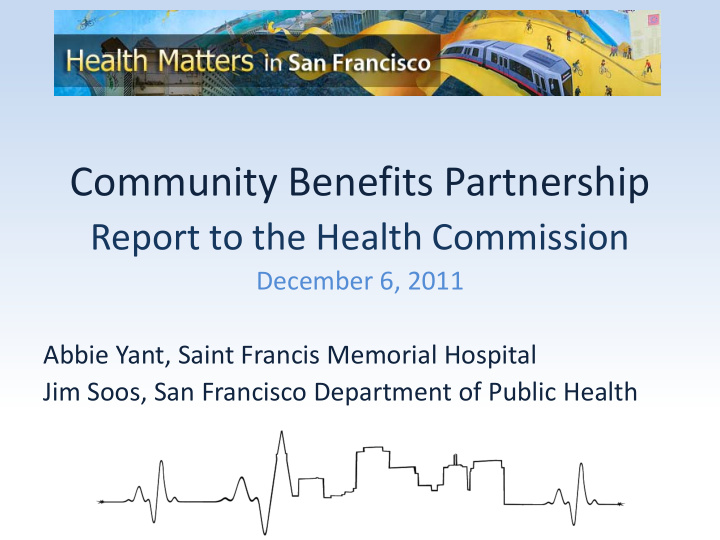



Who We Are Community Benefits Partnership Report to the Health Commission December 6, 2011 Abbie Yant, Saint Francis Memorial Hospital Jim Soos, San Francisco Department of Public Health
Community Benefit Partnership Steering Committee Abbie Yant, SFMH (Co-Chair) Dick Hodgson, SFCCC Jim Soos, SFDPH (Co-Chair) Barry Lawlor, SMMC Cecilia Thomas, CPMC Michael Huff, AAHDP Gloria Thornton, Anthem BC Lara Sallee, Kaiser Permanente Ron Smith, Hospital Council Administrative Support: Stuart Fong, CHASF Meghan Daniels, Circlepoint Wylie Liu, UCSF Dana Gregg, Circlepoint
State Law Produces Partnership • SB 697 (1994) results in Building a Healthier SF • 6 BHSF needs assessments since 1996 • 2007 – Health Matters in SF • Community Benefits Partnership in 2007 • 2010 needs assessment – Community Vital Signs
Organizational Structure San Francisco Community Benefit Partnership Building a Healthier San Francisco Charity Care Project Needs Assessment Charity Care Report
Context for Planning Mandate or Requirement Partner Impacted SB 697 (1994) Non-Profit Hospitals New IRS Rules under federal ACA Non-Profit Hospitals Public Health Accreditation Board (PHAB) DPH Health Care Services Master Plan All Community Transformation Grant All
Community Vital Signs Community Health Goals Increase Access to Quality Medical Care • Increase Physical Activity and Healthy Eating to Reduce Chronic • Disease Stop the Spread of Infectious Diseases • Improve Behavioral Health • Prevent and Detect Cancer • Raise Healthy Kids • Have a Safe and Healthy Place to Live • Improve Health and Health Care Access for Persons with Disabilities • Promote Healthy Aging • Eliminate Health Disparities •
Challenge: How to “Move the Needle” on Each Indicator? Following September 2010 Launch of CVS: Identify the work being done across SF on • each indicator Five stakeholder meetings between 2/11 • and 6/11 addressing each goal & indicator “Champion” identified for each indicator: • Assess current state of activity – Outline plan/ideas to “move the needle” – September 9, 2011 Champions meeting to • share findings & ideas to improve health More than 100 project ideas shared •
Moving Forward: Criteria to Evaluate Indicator represents a health disparity • Achievability given the scope of the problem • Sufficient data on the current status of the problem • Modest capacity to affect change • Problem is demonstrated – “Target Not Met” • Gap in resources or services • No existing network with capacity • Champion identified an actionable project • Intervention is reasonably doable • Priority to projects that affect multiple indicators • BHSF can make a concrete contribution •
Moving Forward: Next Steps • Using the 11 criteria to determine which projects to support & how to support them • Working with DPH and others to ensure that assessment and planning are coordinated • Looking toward 2013 assessment to demonstrate progress in ten goals
Stakeholder Updates • Jacque McCright, SFDPH STD Prevention and Control, “Chlamydia Incidence Rate” • David Pating, M.D., Kaiser Permanente SF, “Age-Adjusted Death Rate Due to Suicide” • Ria Mercado, DAAS, “Hospitalization Rate Due to Hip Fracture in Women/Men Age 65+”
Questions/Comments
Recommend
More recommend